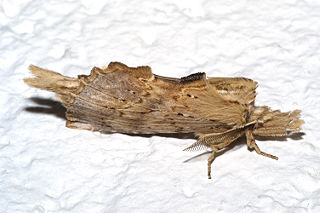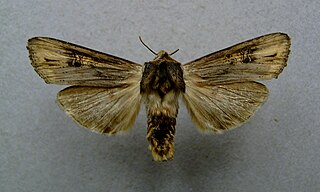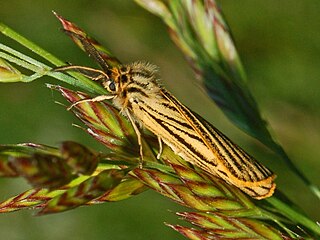
Skippers are a group of butterflies placed in the family Hesperiidae within the order Lepidoptera. They were previously placed in a separate superfamily, Hesperioidea; however, the most recent taxonomy places the family in the superfamily Papilionoidea, the butterflies. They are named for their quick, darting flight habits. Most have their antenna tips modified into narrow, hook-like projections. Moreover, skippers mostly have an absence of wing-coupling structure available in most moths. More than 3500 species of skippers are recognized, and they occur worldwide, but with the greatest diversity in the Neotropical regions of Central and South America.

The buff ermine is a moth of the family Erebidae. It is sometimes placed in the genus Spilosoma. The species was first described by Johann Siegfried Hufnagel in 1766. It is found throughout the temperate belt of the Palearctic region south to northern Turkey, Georgia, Kazakhstan, southern Siberia, eastern Mongolia, Amur Region, China, Korea and Japan.

The flame shoulder is a moth of the family Noctuidae. The species was first described by Carl Linnaeus in 1761. It is distributed throughout the Palearctic from Ireland in the west to Siberia then Korea and Japan in the east.

Cerapteryx graminis, the antler moth, is a moth of the family Noctuidae. It is a common species throughout most of Europe but is lacking in the very dry southern regions. The northernmost occurrence is Iceland, and above the Arctic Circle. It also occurs in Siberia and in North Mongolia. The species has been introduced to North America. In the Alps it rises to an altitude of 2100 meters.

The marbled beauty is a moth of the family Noctuidae. The species was first described by Johann Siegfried Hufnagel in 1766. It is an abundant species throughout most of Europe east to the Urals, and it is probably the most common lichenivorous moth of the Palearctic realm.

The mouse moth is a moth of the family Noctuidae. It is a widespread species with a Holarctic distribution.

The dun-bar is a moth of the family Noctuidae. It is a common Palearctic species.

Pterostoma palpina, the pale prominent, is a moth from the family Notodontidae. The species was first described by Carl Alexander Clerck in 1759.

Heliothis peltigera, also known as the bordered straw, is a species of moth of the family Noctuidae.

Caradrina clavipalpis, the pale mottled willow, is a moth of the family Noctuidae. The species was first described by Giovanni Antonio Scopoli in his 1763 Entomologia Carniolica. It is found in the Palearctic realm. It is an introduced species in North America, where it was first reported from Queens in New York City in 1993. In 2009 it was found in Rochester, New York, so it appears to be established and spreading.

Xylena exsoleta, the sword-grass, is a species of moth of the family Noctuidae.

Spilosoma lubricipeda, the white ermine, is a moth of the family Erebidae. It is found throughout the temperate belt of Eurasia from Europe through Kazakhstan and southern Siberia to Amur Region, China, Korea and Japan. In China several sibling species occur.

Spiris striata, the feathered footman, is a moth of the family Erebidae. The species was first described by Carl Linnaeus in his 1758 10th edition of Systema Naturae.

Euxoa obelisca, the square-spot dart, is a moth of the family Noctuidae. It is found in the Palearctic realm.
Pedoptila is a genus of moths in the family Himantopteridae.

Standfussiana lucernea, the northern rustic, is a moth of the family Noctuidae. It is found from the Iberian Peninsula, Italy and Greece in southern Europe, north through most of the continent up to Fennoscandia west to Ireland and Iceland.
Pedoptila catori is a moth in the Himantopteridae family. It was described by George Thomas Bethune-Baker in 1911. It is found in the Democratic Republic of the Congo (Katanga), Nigeria and Uganda.
Pedoptila nemopteridia is a moth in the Himantopteridae family. It was described by Arthur Gardiner Butler in 1885. It is found in the Democratic Republic of the Congo, Ghana, Sierra Leone and South Africa.
Pedoptila thaletes is a moth in the family Himantopteridae. It was described by Herbert Druce in 1907. It is found in the Republic of the Congo and Cameroon.

Arhopala similis is a species of butterfly belonging to the lycaenid family described by Hamilton Herbert Druce in 1895. It is found in Southeast Asia . In this species, contrary to Arhopala catori, all the 4 spots in the costal area of the hindwing beneath are distinctly developed and in distinct light rings. In the forewing the postmedian transverse band is entirely absent, whilst in the hindwing it is broken up into hardly contiguous rings. Above the male is still more broadly margined with black than A. catori, particularly in the apex; the female is very similar to it, lighter blue.















